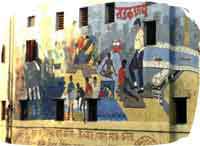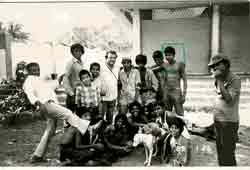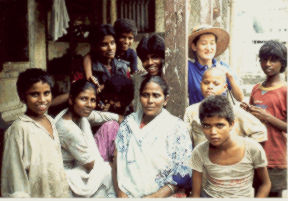|
Sadak Chaap is a loose but fast-growing federation of street children in Bombay. "Sadak Chaap" is a term by which children refer to themselves. "Chaap" means stamp, and "Sadak" is street - the term aptly describes those who carry "the stamp of the street".
The simplest definition is one the children have developed themselves, "without a roof and without roots.. roofless and rootless". |
 |
|
The Sadak Chaap Process operates for children who have run away from home, seeks to create network for and by the street children, and initiates all rehabilitation on the basis for the children's aspirations.
So the process constantly challenges the Juvenile Justice system which does not work. And whose remanding to state custody is one of the most archaic and senseless process in which young children feel criminal and in "Jail", and where most young children what to be something and have wanted to achieve something before they reconcile with their families. |
|
| Starting in 1987-88 In 1987-88, many events occurred at the same time. The Salatian priests all over India were celebrating 100 years of their work since DON BOSCO came to Mumbai and began to work with street children. At the same time the UNICEF began to share issues and concerns about children who were vulnerable and by themselves on the street. Taking the Latin American Experience which was a decade ahead of what was beginning in Asia, children in Brazil and other Latin American cities were being inducted into prostitution, illegal drugs and crimes and often shot by both, the underworld and the police. Together with the young priests from Don Bosco at Wadala we began to explore who these children are and where they come from and what they do. At that time we had no plans to start any activities of programs with the street children. We were supporting the exploration of who these children were and where they stayed and what they did with Don Bosco priests, who were very keen that their order develop a good program for street children. This initiated the survey of 10,000 children who were counted by a group of 124 volunteers from NSDF, Mahila Milan and Don Bosco, and which in turn gave rise to the study "Waiting for Tomorrow" |
 As people working with pavement dwellers, we too, SPARC, NSDF & Mahila Milan, were asked to come and share our views about this process, and as we began to explore the implications of this new idea, we began to see that in the Indian context, families, however poor they were, were an important shield between the world and the child. But that those children who were by themselves were very vulnerable. |
|
Samina and others become the aunts.
NSDF and Mahila Milan began to provide the community centres where they operated as night shelters to the Sadak Chaaps. The pressure to get some earmarked space from the city remained, but the beginnings of trying to integrate children into community mainstream had begun. The women from the Byculla Mahila Milan became the aunts. It was a very mutually supportive process, when she and other leaders accepted these young boys and ensured that they maintained basic discipline to make other community households feel secure around the children. The boys too, saw the advantage of being around women who knew the police so well, that when they were "caught" by the police, they said Mahila Milan was looking after them, and that was confirmed when a phone call was made to Byculla and Samina would roar on the Phone.." Mere bacche ko kyon pakada re!" ( Why have you caught one of my children? ) To date this remains an unwritten but routine strategy for children to evade getting remanded into state custody. All Police stations know about this arrangement. |
 Samina had many children and was 'Appa' to all the other children in the neighbourhood, now she has many more such children to nag and bully! Samina had many children and was 'Appa' to all the other children in the neighbourhood, now she has many more such children to nag and bully! |
| FEDERATIONS AND SADAK CHAAP : Mahila Milan and the Federations felt a strong bond with these children. Rather than try and constrain them in an environment which is hostile to their needs, it was felt that a more effective strategy would be to allow them to form their own loose federation, which could then link up with the SPARC-NSDF-MM nexus. The children decided to call this federation "Sadak Chaap" which literally means the stamp of the street. The main problem which these children face is that of night shelters, and this need has been met to an extent by allowing the Byculla resource centre to be used as one. Other problems such as antagonism by the police and on-the-spot medical care are also being looked after by the older members of all the federations. The main support which these children need is in their transition into adulthood, and this is provided by the women of Mahila Milan. |
|
| Achievements: The achievements of the project can be located within the following areas:
|
|
| Pproblems
There are many problems and difficulties which accompany each of the achievements:
|
|
| Lessons: There are lessons at many levels:
|
|